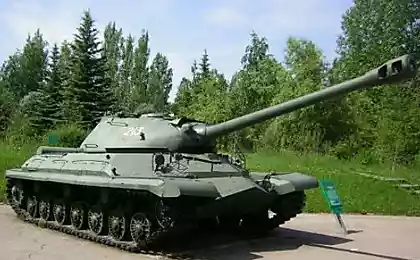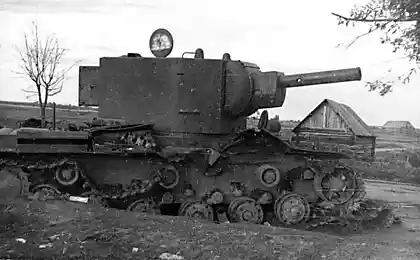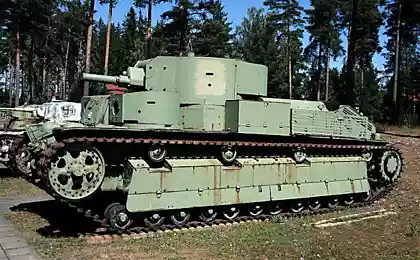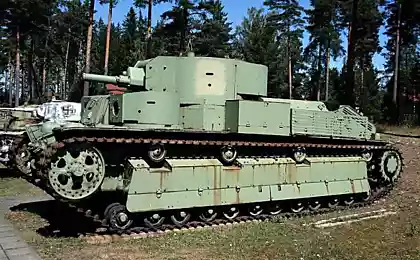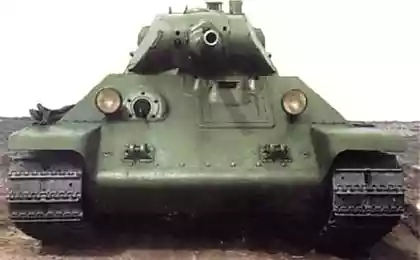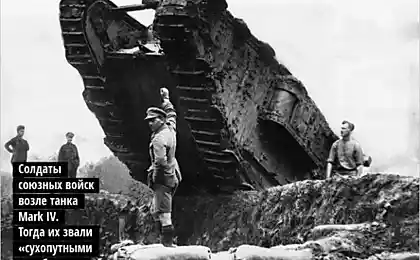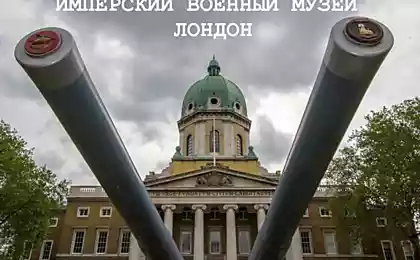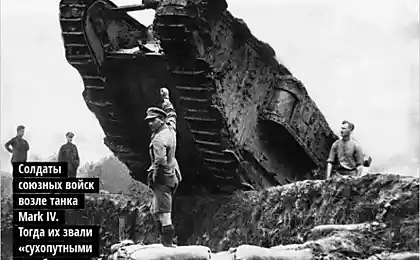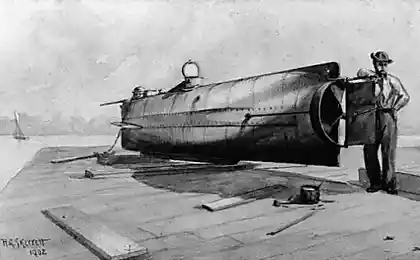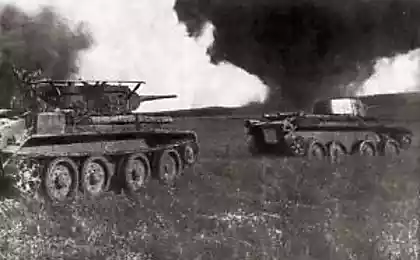1107
Tank hydrofoil
The destruction of water crossings, blasting bridges, for example, the retreating armies - a common occurrence during the war, as the pontoon, such as the upcoming party, respectively. But what if the water barrier does not allow time to clean the ferry? What if you need not cross the river, and the Strait? This idea sets the Soviet command in the late 50s of the last century, and design offices have implemented a stunningly elegant and perfect work of Soviet engineering. Project 80.
9 posts with pictures, video and text. Please do not interrupt, thank you.
Sources: PM, lj, internets
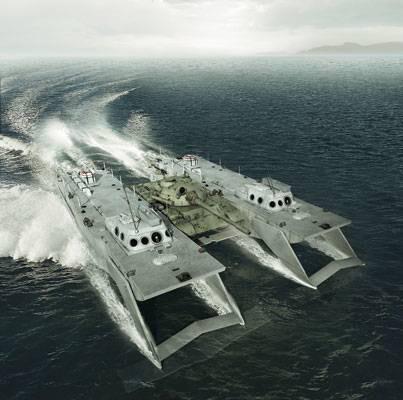
In 1951, the Union began work on the creation of individual boats for outboard tanks. The first samples for the T-54 were made in 1952 and at the same time were tested on the river Oka. In 1953-54 it had held preliminary sea trials. In 1957 watercraft was taken into service under the designation DC-54. Such funds Motorized Rifle Division, of the state, had to be up to 187 units (the number of tanks). Production was conducted in Navashino plant №342, and retrofitting of tanks at the Kharkov plant №75. T-54 adapted for use in boats received factory index "Object 485».
In parallel, work was done to build boats for the T-55 and ZSU-57-2 (have designations, respectively, PST-55 (K-4183 project), and PST. Modified ZSU-57-2 received index "object 510"). In 1959, №342 and №174 plants were carried out work on the unification of boats. In 1960, an improved flotation device under the designation DC-U (Universal) was made on arms SA.
Set DC-U consists of five steel pontoons (the two main board, the two flip-board and stern), filled with foam. The total weight of the boats was 10 tons. Buoyancy to the tank T-54 was 40%. Movement afloat performed using two propellers power takeoff from the driving wheels of the tank. Maximum speed of the tank with a flotation device on land was 19 km / h, afloat - 12 km / h. It may be towed at speeds of up to 15 km / h. Watercraft fuel tanks had a capacity of 500 liters, which provides a range of 60-80 km (fuel tanks of the tank is not consumed)
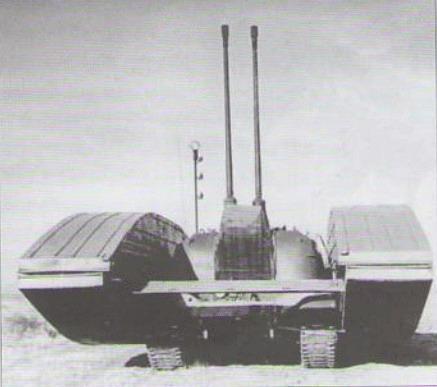
Overcoming water obstacles could be done with waves up to 5 points. Shooting from guns - to 1, 5 points (for the ZSU-57-2 - shooting anti-aircraft targets with waves up to 2 points). Along with a tank certified to carry a personal weapon assault up to 25 people (for the ZSU-57-2 - up to 40 people), in finding a landing on the deck of the boat Shooting guns is prohibited. The mounting of the boats on the tank was made by the crew within 35 minutes, the reset is carried out instantly, without leaving the crew out of the car. Flotation device PST-54 transported on four vehicles of type ZIS-151
In 1962 he tested a lightweight boat SS-1 to T-55 tank and tractor BPS-2. Weight PS-1 was 5, 5 tons (pontoons no steel and aluminum alloy), the maximum speed of the tractor BPS-2 watercraft: afloat forward - 13, 7 km / h, back - 8 km / h, afloat for tow - up to 19 km / h, on a dirt road - 25 km / h. Cruising with the additional fuel tanks - up to 100 km. Watercraft transported two ZIL-157B.
Tests have shown that for seaworthiness PS-1 exceeds the DC-54 and DC-U. In 1965, after completion, watercraft under the designation DC-63 was accepted for service.
In the future, work on the improvement of water craft, which led to modifications of DC and DC-63M-64 tanks T-55 and T-62.
00:49 Since the late 1950s, in parallel with the displacement landing craft began designing high-speed amphibious hydrofoil boats. He developed terms of reference and was the first military project curator Pavel Murgalev - a legendary figure. It was he who invented the anti-mine flail to the T-34, put into service in 1942 and passed the entire Second World War. TK for high-speed tank landing craft provided for the ability to quickly take on board the T-54 (later T-55), the speed of over 50 km / h and high navigability, in particular the ability to move with waves of up to five points. An important and perhaps most difficult requirement was the ability to fire directly from the water.
Development of craft began in the late 1950s. Tank pontoon, equipped with its own engine and hydrofoil, designed to CB "Volgobaltsudoproekt" under the direction of Michael Shchukin. The wings were developed in the Central Bureau of Hydrofoil factory "Red Sormovo" (now the CDB for SPC them. RE Alekseev) - in the same place where they were born-speed ships "Rocket" and "Meteor". The device is on and the engine "Missiles" - diesel M-50, capable of a peak power of 1200 hp

Set speed tank landing craft consisted of two boats. Like a conventional non-motorized pontoons, they were hung on the sides of a tank equipped with special lugs. Each boat had two cylinder in which boats are lifted above the ground. In this position the tank enters the water to some rainfall.
In the transport position Hydrofoil for boats have been raised and more reminiscent of a racing car splashes. Raised and pressed to the board were tie-wings in front and behind the tank. Upon reaching the displacement condition halves and snap ties fell, forming rigid crossbars at the bottom of the boat. Thanks screed boats could carry a tank, not to the sides. The next moment, the cylinders have raised the tank above the water level and pontoons started displacement. The propeller and steering boats are aligned with the rear hydrofoil, so the depth of immersion of the screw can be adjusted. Watercraft waste at depth in the displacement mode, then fell completely underwater wings.
Full acquisition of boats before going on the water takes 45 minutes and get rid of pontoons, coming ashore, the tank might just 3 minutes.

By 1966, at Navashino shipbuilding plant was made mock boat hydrofoil on a scale of 1: 2, which was tested on a modest river Tёshe. And in the next year, a full-size prototype went to the big water - in Sevastopol. "The crew of each car was small, only two people - a driver and mechanic, - says a leading specialist Navashino plant Valentin Bogatyrev Galin - with one driver can manage both private boats and watercraft in general. Management control surfaces and engine using the electric motors and synchronized by cable ».
On the water watercraft "Project 80" immediately exceeded the design speed, speeding up to 58 km / h. But with the strength of the structure having problems. During one of the tests broke screed. The boats went out and the tank went under water. By the time the machine is not yet time to go deep, so neither the crew nor the tank is not affected. To investigate the incident in Sevastopol sent a team of specialists from the "Volgobaltsudoproekta." "We stuck to the wings, tie a plurality of sensors, fix them with epoxy resin, connected to the control equipment specially installed cabin and went to sea, - says Paul S. Karpov, who was then the designer of the 1st category in the sector strength. - As a result, we have found that, in the zone of maximum stress concentration on the wing was propylene groove, which became the cause of the break ».
And yet, the designers managed to bring the car to mind. Shipyards in Navashino, Rybinsk, Astrakhan was built 13 sets of high-speed tank landing boats "Project 80". Experimental winged battalion of tanks based in Sevastopol. It was rumored that some of the vehicles went to the Baltic.
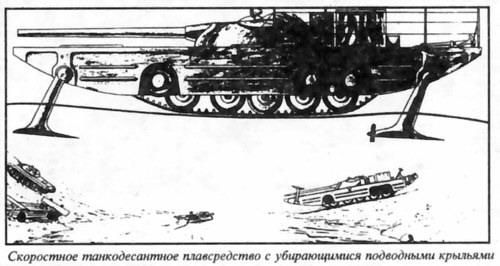
And in 1971, the project was closed. Why - I could not answer any of our consultants today. However, not difficult to guess. To the tank could carry the two 15-ton boat, it must be installed fastening units, the mass of which, according to conservative estimates, will amount to 2-5% of the weight of the tank. It's about a ton of dead metal, which may need to tank only once, but he must always carry with them.
Suspension of the tank is not designed for such loads it is believed that even the weight of the blade trawl KMT-6 (800 kg) leads to rapid destruction of the front roller bearings. If the chassis is designed for the additional weight of 30-40 m, then freed from the vessels after exiting the water tank will be too rigid suspension, resulting in a complete loss of its cushioning properties. Tank can not normally go by land and fire.
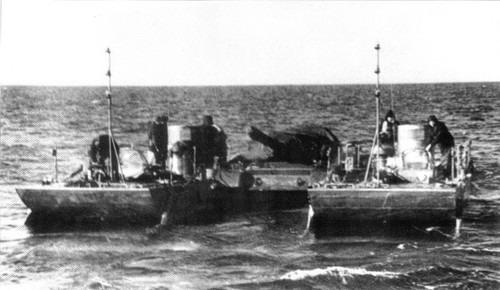
Yet the main problem of "Project 80" - tactical. Amphibious operation involves the simultaneous participation of several hundreds or even dozens of ships moving on a strict schedule. On the beach in a certain order must be planted tanks, infantry, artillery, engineers, facilities security. By the time the battalion approached "Project 80" to the bank it should be covered with naval artillery fire. For conventional landing craft this issue is easily solved - artillery piece is on the landing craft themselves, some in ships artpodderzhki that move along with landing ships. And what about the "Project 80"? Court artpodderzhki accompany such a battalion can not, because the speed of their two to three times lower. So they have to move out to the place of landing before. And in this case, it lost the very meaning of a high-speed landing tanks: the enemy, seeing the ships artpodderzhki will be ready to meet the "winged tanks' fire.
What tanks without infantry without artillery, without sappers, without ammunition supply? Ammunition enough for 30 minutes of battle, if not before tanks pozhgut enemy grenade throwers. Perhaps tank hydrofoil would suddenly come to the war zone as reinforcements landed a bit further to unprotected parts of the coast. But you will agree, this is a very modest role for such an ambitious project.
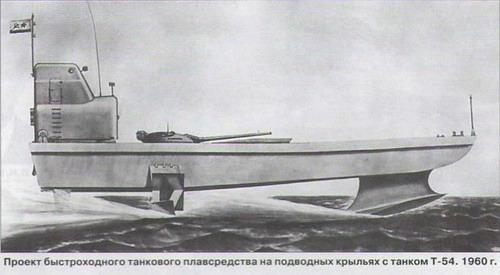
The creators of "Project 80" focused on solving a single problem very narrow - creating a craft capable of transporting a tank of water at high speed. They left out of sight of many of the technical and tactical issues, which ultimately led to the collapse of the project. The last "Save" pontoon, or rather his body, kept in a closed fund of the Museum of Armored Forces in Kubinka. When they wanted to restore the museum staff did not succeed: all attachments of the machine, including the wings and tie, irretrievably lost. It launches "Project 80" made of high-quality and expensive aluminum.
That's all I wanted to say. Thank you.

Source:
9 posts with pictures, video and text. Please do not interrupt, thank you.
Sources: PM, lj, internets

In 1951, the Union began work on the creation of individual boats for outboard tanks. The first samples for the T-54 were made in 1952 and at the same time were tested on the river Oka. In 1953-54 it had held preliminary sea trials. In 1957 watercraft was taken into service under the designation DC-54. Such funds Motorized Rifle Division, of the state, had to be up to 187 units (the number of tanks). Production was conducted in Navashino plant №342, and retrofitting of tanks at the Kharkov plant №75. T-54 adapted for use in boats received factory index "Object 485».
In parallel, work was done to build boats for the T-55 and ZSU-57-2 (have designations, respectively, PST-55 (K-4183 project), and PST. Modified ZSU-57-2 received index "object 510"). In 1959, №342 and №174 plants were carried out work on the unification of boats. In 1960, an improved flotation device under the designation DC-U (Universal) was made on arms SA.
Set DC-U consists of five steel pontoons (the two main board, the two flip-board and stern), filled with foam. The total weight of the boats was 10 tons. Buoyancy to the tank T-54 was 40%. Movement afloat performed using two propellers power takeoff from the driving wheels of the tank. Maximum speed of the tank with a flotation device on land was 19 km / h, afloat - 12 km / h. It may be towed at speeds of up to 15 km / h. Watercraft fuel tanks had a capacity of 500 liters, which provides a range of 60-80 km (fuel tanks of the tank is not consumed)

Overcoming water obstacles could be done with waves up to 5 points. Shooting from guns - to 1, 5 points (for the ZSU-57-2 - shooting anti-aircraft targets with waves up to 2 points). Along with a tank certified to carry a personal weapon assault up to 25 people (for the ZSU-57-2 - up to 40 people), in finding a landing on the deck of the boat Shooting guns is prohibited. The mounting of the boats on the tank was made by the crew within 35 minutes, the reset is carried out instantly, without leaving the crew out of the car. Flotation device PST-54 transported on four vehicles of type ZIS-151
In 1962 he tested a lightweight boat SS-1 to T-55 tank and tractor BPS-2. Weight PS-1 was 5, 5 tons (pontoons no steel and aluminum alloy), the maximum speed of the tractor BPS-2 watercraft: afloat forward - 13, 7 km / h, back - 8 km / h, afloat for tow - up to 19 km / h, on a dirt road - 25 km / h. Cruising with the additional fuel tanks - up to 100 km. Watercraft transported two ZIL-157B.
Tests have shown that for seaworthiness PS-1 exceeds the DC-54 and DC-U. In 1965, after completion, watercraft under the designation DC-63 was accepted for service.
In the future, work on the improvement of water craft, which led to modifications of DC and DC-63M-64 tanks T-55 and T-62.
00:49 Since the late 1950s, in parallel with the displacement landing craft began designing high-speed amphibious hydrofoil boats. He developed terms of reference and was the first military project curator Pavel Murgalev - a legendary figure. It was he who invented the anti-mine flail to the T-34, put into service in 1942 and passed the entire Second World War. TK for high-speed tank landing craft provided for the ability to quickly take on board the T-54 (later T-55), the speed of over 50 km / h and high navigability, in particular the ability to move with waves of up to five points. An important and perhaps most difficult requirement was the ability to fire directly from the water.
Development of craft began in the late 1950s. Tank pontoon, equipped with its own engine and hydrofoil, designed to CB "Volgobaltsudoproekt" under the direction of Michael Shchukin. The wings were developed in the Central Bureau of Hydrofoil factory "Red Sormovo" (now the CDB for SPC them. RE Alekseev) - in the same place where they were born-speed ships "Rocket" and "Meteor". The device is on and the engine "Missiles" - diesel M-50, capable of a peak power of 1200 hp

Set speed tank landing craft consisted of two boats. Like a conventional non-motorized pontoons, they were hung on the sides of a tank equipped with special lugs. Each boat had two cylinder in which boats are lifted above the ground. In this position the tank enters the water to some rainfall.
In the transport position Hydrofoil for boats have been raised and more reminiscent of a racing car splashes. Raised and pressed to the board were tie-wings in front and behind the tank. Upon reaching the displacement condition halves and snap ties fell, forming rigid crossbars at the bottom of the boat. Thanks screed boats could carry a tank, not to the sides. The next moment, the cylinders have raised the tank above the water level and pontoons started displacement. The propeller and steering boats are aligned with the rear hydrofoil, so the depth of immersion of the screw can be adjusted. Watercraft waste at depth in the displacement mode, then fell completely underwater wings.
Full acquisition of boats before going on the water takes 45 minutes and get rid of pontoons, coming ashore, the tank might just 3 minutes.

By 1966, at Navashino shipbuilding plant was made mock boat hydrofoil on a scale of 1: 2, which was tested on a modest river Tёshe. And in the next year, a full-size prototype went to the big water - in Sevastopol. "The crew of each car was small, only two people - a driver and mechanic, - says a leading specialist Navashino plant Valentin Bogatyrev Galin - with one driver can manage both private boats and watercraft in general. Management control surfaces and engine using the electric motors and synchronized by cable ».
On the water watercraft "Project 80" immediately exceeded the design speed, speeding up to 58 km / h. But with the strength of the structure having problems. During one of the tests broke screed. The boats went out and the tank went under water. By the time the machine is not yet time to go deep, so neither the crew nor the tank is not affected. To investigate the incident in Sevastopol sent a team of specialists from the "Volgobaltsudoproekta." "We stuck to the wings, tie a plurality of sensors, fix them with epoxy resin, connected to the control equipment specially installed cabin and went to sea, - says Paul S. Karpov, who was then the designer of the 1st category in the sector strength. - As a result, we have found that, in the zone of maximum stress concentration on the wing was propylene groove, which became the cause of the break ».
And yet, the designers managed to bring the car to mind. Shipyards in Navashino, Rybinsk, Astrakhan was built 13 sets of high-speed tank landing boats "Project 80". Experimental winged battalion of tanks based in Sevastopol. It was rumored that some of the vehicles went to the Baltic.

And in 1971, the project was closed. Why - I could not answer any of our consultants today. However, not difficult to guess. To the tank could carry the two 15-ton boat, it must be installed fastening units, the mass of which, according to conservative estimates, will amount to 2-5% of the weight of the tank. It's about a ton of dead metal, which may need to tank only once, but he must always carry with them.
Suspension of the tank is not designed for such loads it is believed that even the weight of the blade trawl KMT-6 (800 kg) leads to rapid destruction of the front roller bearings. If the chassis is designed for the additional weight of 30-40 m, then freed from the vessels after exiting the water tank will be too rigid suspension, resulting in a complete loss of its cushioning properties. Tank can not normally go by land and fire.

Yet the main problem of "Project 80" - tactical. Amphibious operation involves the simultaneous participation of several hundreds or even dozens of ships moving on a strict schedule. On the beach in a certain order must be planted tanks, infantry, artillery, engineers, facilities security. By the time the battalion approached "Project 80" to the bank it should be covered with naval artillery fire. For conventional landing craft this issue is easily solved - artillery piece is on the landing craft themselves, some in ships artpodderzhki that move along with landing ships. And what about the "Project 80"? Court artpodderzhki accompany such a battalion can not, because the speed of their two to three times lower. So they have to move out to the place of landing before. And in this case, it lost the very meaning of a high-speed landing tanks: the enemy, seeing the ships artpodderzhki will be ready to meet the "winged tanks' fire.
What tanks without infantry without artillery, without sappers, without ammunition supply? Ammunition enough for 30 minutes of battle, if not before tanks pozhgut enemy grenade throwers. Perhaps tank hydrofoil would suddenly come to the war zone as reinforcements landed a bit further to unprotected parts of the coast. But you will agree, this is a very modest role for such an ambitious project.

The creators of "Project 80" focused on solving a single problem very narrow - creating a craft capable of transporting a tank of water at high speed. They left out of sight of many of the technical and tactical issues, which ultimately led to the collapse of the project. The last "Save" pontoon, or rather his body, kept in a closed fund of the Museum of Armored Forces in Kubinka. When they wanted to restore the museum staff did not succeed: all attachments of the machine, including the wings and tie, irretrievably lost. It launches "Project 80" made of high-quality and expensive aluminum.
That's all I wanted to say. Thank you.

Source:
